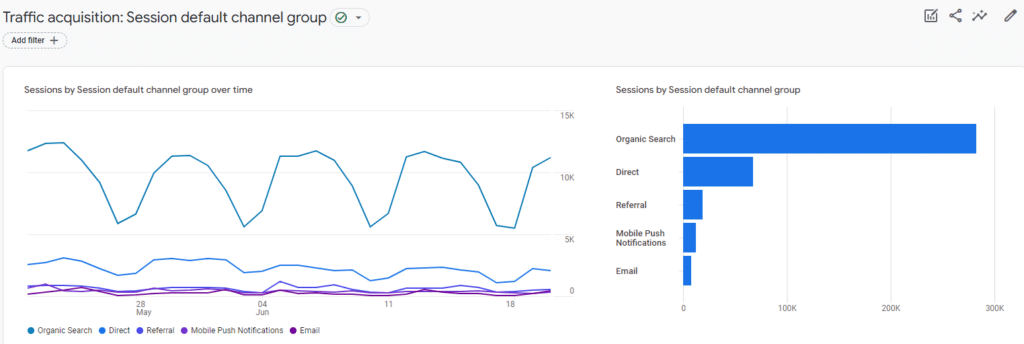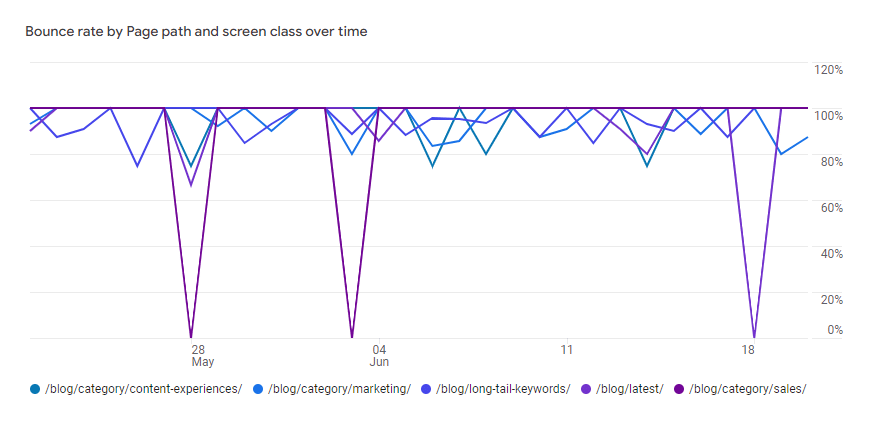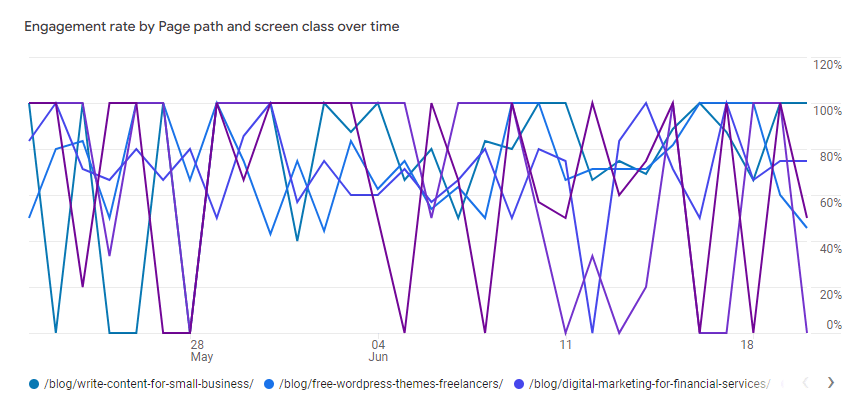Digital Marketing is currently the key ally of companies that want to establish or expand their presence on the Internet.
Through practices such as content production, investments in social media, and paid advertising, it is possible not only to attract potential customers but also to direct their journey through the sales funnel.
As you know, you should design the details of your digital strategy according to the characteristics of your company and your target audience.
To do so, it’s essential to adopt an analytical approach, observing the aspects that are performing well and those that need optimization — that’s where Digital Marketing metrics come in.
Using performance indicators is essential for you to keep your strategy in constant improvement, delivering better results to your company.
To help you achieve this goal, we created this post listing and explaining the 14 main Digital Marketing Metrics.
Keep Reading!
- 1. Total Website Visits
- 2. Traffic by Channels
- 3. Inbound Links to the Website
- 4. Number of New Visitors vs Number of Return Visitors
- 5. Interactions per Visit
- 6. Bounce Rate
- 7. Exit Rate
- 8. Mobile Traffic
- 9. Click-Through Rate (CTR)
- 10. Cost per Visitor (CPV) and Revenue per Visitor (RPV)
- 11. Cost per Conversion
- 12. Cost per Acquisition
- 13. Net Promoter Score
- 14. Engagement Rate
- Wrap Up
Download this post by entering your email below
1. Total Website Visits
In order to establish your presence on the Internet, it is essential to have a website.
Besides centralizing the most relevant information about your business, you can use the portal for developing a blog, which is key to attracting and nurturing leads.
Therefore, one of the most important Digital Marketing metrics is Total Site Visits, which, as the name indicates, measures the overall number of visitors to your website.
In the ideal scenario, Total Site Visits should present stable growth from week to week.
However, if you notice a drop in the volume of visits, it is time to take action to make the website more attractive to consumers.
2. Traffic by Channels
Besides knowing your total traffic volume, it is important to analyze where each visitor comes from.
After all, for your strategy to achieve good results, you must rely on a variety of channels and monitor them individually. Therefore, segregate the traffic sources and identify the most relevant ones.
If you notice, for example, that few of your visitors arrive by organic search, this may indicate that your SEO approach needs optimization.
These are the most commons traffic sources for your site:
- direct visitors: the users who access your website by typing the URL;
- organic visitors: those who reach your website after using a search engine tool;
- referrals: visitors who visit your page after clicking on a link;
- email: visitors who find your page through email marketing, such as newsletters, nurture flows, and campaigns;
- social media visitors: those who come to your website from social media channels;
- paid visitors: users who found your content through the ads on search engines.

3. Inbound Links to the Website
Measuring Inbound links to your website is important to evaluate the performance of your link-building strategy.
This is an issue whose importance goes beyond the optimization of your website traffic since the number of links directing to your page is a factor taken into account by Google’s algorithm.
To get this data, you can use a specific tool such as Moz or SEMrush. One tip to get more links is to produce interactive content, which is highly engaging and encourages sharing.
4. Number of New Visitors vs Number of Return Visitors
Comparing the number of new visitors with the number of return visitors is a very efficient way to measure the effectiveness of your new content and your website as a whole.
To use this metric, start by establishing the evaluation period, which is usually weekly or monthly.
The percentage of return visitors indicates how engaging your content is.
In a situation where there are many new accesses and few returns, for example, you can assume that your strategy is succeeding in attracting interest.
Still, your content is not good enough to convince them to return.
5. Interactions per Visit
Getting traffic is great, but what you really want is for your visitors to interact with your content.
So map the audience’s experience and learn what types of triggers are most effective in stimulating interaction.
Over time, you’ll notice patterns that can optimize your strategy. If visitors, for example, spend more time on pages with visual content, investing more time in this sort of material can be a great benefit to your relationship with your audience.
6. Bounce Rate
The Bounce Rate indicates the number of people who visited your website and left quickly, without opening other pages or performing any kind of action.
A high Bounce Rate is a strong signal that your digital strategy must be optimized. This can happen due to a series of reasons such as you are attracting the wrong audience to your website, you don’t have good CTAs, or the content is not valuable enough to the reader.
In this case, you need to carefully analyze what is causing this rate and map what improvements can be done.

7. Exit Rate
Unlike Bounce Rate, Exit Rate indicates how many users have left your website from a specific page.
Presented in percentage format, the Exit Rate is calculated by dividing the number of visitors who got out of the page by the total number of visits it received.
This is a critical metric to identify holes in your conversion strategy. A page with a high Exit Rate may show responsiveness flaws or simply offer content considered irrelevant by the audience.
8. Mobile Traffic
As you know, most people use mobile devices to browse the Internet, which makes Mobile Traffic a vital part of your strategy.
In this process, it’s important to ensure your pages are mobile-friendly in order to optimize the user experience and decrease both Bounce Rate and Exit Rate.
To evaluate your strategy, find out the percentage of visitors who access from mobile devices.
Also, try to understand what types of equipment and browsers are used and what kinds of content are most consumed by mobile users.
9. Click-Through Rate (CTR)
Click-Through Rate is one of the most important Digital Marketing metrics in the context of Email Marketing and PPC efforts.
It is the ratio of users who click on a specific link to the number of total users who view it. When we talk about paid media, the higher the CTR, the lower will be your cost per click.
10. Cost per Visitor (CPV) and Revenue per Visitor (RPV)
While Cost per Visitor calculates the total investment made to acquire a visitor, Revenue per Visitor estimates how much your brand earns with each visit.
In order to decide whether or not you are on the right track, a valuable tip is to compare both metrics.
If the RPV is higher than the CPV, it seems that your efforts are worthwhile.
The calculation to reach these values is simple. The CPV is calculated by dividing the visitors generated by a campaign by the amount invested to do so.
So, if you spent $ 500 on sponsored links and they generated 1000 visitors, the CPV was $ 0.5.
You can find the RPV by dividing the revenue generated by the campaign by the number of visitors attributed to it.
It is important that you calculate these metrics for every one of your traffic channels to identify the most relevant ones.
11. Cost per Conversion
To calculate the Cost per Conversion, you must first define what is considered a conversion.
It can be the moment when the visitor becomes a lead, the moment when they download material or even the act of purchasing something.
After setting your parameter, it’s important to work on keeping the Cost per Conversion low.
After all, if the value is too high, your company may face difficulties even with a large percentage of conversions.
12. Cost per Acquisition
Unlike Cost per Conversion, Cost per Acquisition has only one focus: revenue.
The metric is used to calculate the amount invested for each individual who becomes a paying customer.
In other words, the CPA indicates exactly how many dollars you need to spend to convince someone to invest in your solutions.
13. Net Promoter Score
Net Promoter Score is a metric widely used to define the degree of loyalty of your customers. It is only one question, which is usually sent in follow-up emails.
The question is: “How likely is it that you would recommend this company to a friend or colleague?”
Customers must answer with a value between 0 and 10, is classified into three categories:
- promoters (score 9 to 10): enthusiasts of your brand with a high possibility to indicate it to third parties;
- passive (score 7 to 8): satisfied with the services offered, but unenthusiastic. They will leave whenever they see a better opportunity;
- detractors (score 0 to 6): unsatisfied customers who spread negative comments about your brand.
14. Engagement Rate
This is a metric that you can use on more than one channel, but it is usually applied in social media strategies.
The goal is to identify the percentage of your total audience that actively engages with the posted content, either through likes, comments, or sharing.

Wrap Up
By understanding the main Digital Marketing metrics, you can face your strategy with a more analytical look and find room for optimization.
It is important to define your key performance indicators in anticipation, to focus on the numbers that really are relevant for the evaluation of your efforts.
Do you think this post will help you structure your Digital Marketing strategy? How about spreading knowledge? Share this content on your social networks and let your friends and colleagues on board!
And remember: one crucial step towards a successful Digital Marketing strategy is ensuring that your website content is of high quality, which will impact all the metrics discussed in this blog.
To help you with that, there’s WriterAccess, our content creation marketplace that can connect you with experienced writers and level up your content quality.
Why not give WriterAccess a try today? Sign up now and get 14 days of free access to our network of expert writers. Discover for yourself what great content can do for your business!










